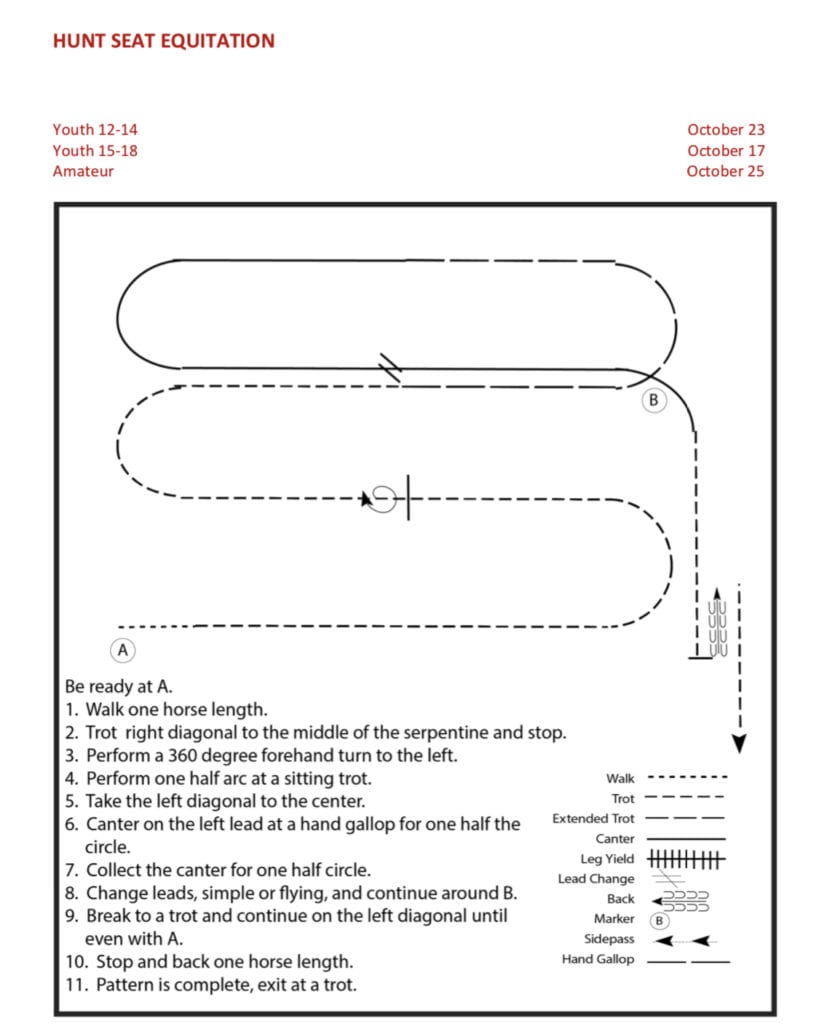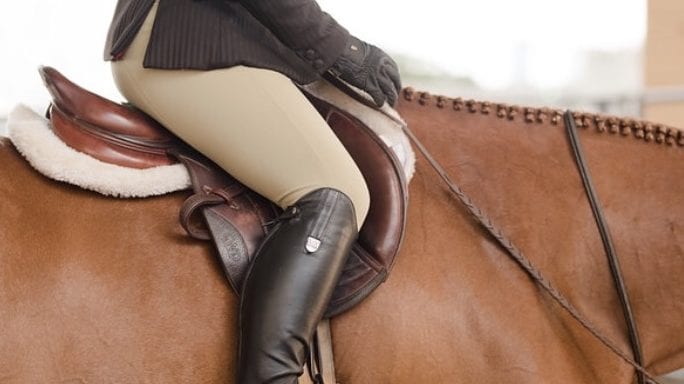GoHorseShow would like to thank Congress Judge Jan Hoskin-Hay, for taking the time to break down the Congress Youth 12-14, 15-18, and Amateur Hunt Seat Equitation pattern for us. A huge bonus is that Hay is a judge at this year’s show. As an AQHA judge, she has had the privilege of judging World Shows and significant events all over the world.
We would also like to thank HorseShowPatterns.com for allowing us to post the pattern in the article. You may view the pattern displayed below or download it here. GoHorseShow chose this pattern because we thought it would be beneficial to breakdown one of the more challenging patterns as some of the less complicated patterns have many of the same maneuvers.
Hunt Seat Equitation Pattern Breakdown as seen by Jan Hoskin-Hay
 With ten maneuvers and only two markers in this pattern, placement and execution will be essential to ensure a smooth, penalty-free presentation. The pattern is your road map; each maneuver should be planned accordingly to the distance & location as drawn on your map to try and eliminate the chance of incurring any location penalties. Of course, the rider who shows correctness, control AND a higher degree of difficulty in maneuvers and run overall, is more likely to be at the top end of the judge’s card.
With ten maneuvers and only two markers in this pattern, placement and execution will be essential to ensure a smooth, penalty-free presentation. The pattern is your road map; each maneuver should be planned accordingly to the distance & location as drawn on your map to try and eliminate the chance of incurring any location penalties. Of course, the rider who shows correctness, control AND a higher degree of difficulty in maneuvers and run overall, is more likely to be at the top end of the judge’s card.
I like to see a forward-moving execution of the pattern for Hunt Seat Equitation. It shows a degree of difficulty, communication, and confidence between horse & rider. This particular pattern has several arcs and half-circles, therefore, the rider should always be looking ahead, planning each maneuver with a secure lower leg and heels down at all times. Hands should be over and in front of the horse’s withers, held slightly apart, making a straight line from the horse’s mouth to rider’s elbow. My biggest pet peeve is to see riders looking down, with their arms glued to their sides & hands dropped into their lap. This is very ineffective and certainly not credit-earning.
The first maneuver calls for the walk for one horse length. Be sure to walk with purpose and confidence.
 You are now picking up the right diagonal at a trot into a serpentine, arcing to the left, and coming to a stop at the center of the serpentine. Keep eyes up and looking forward to where you want to go, maintaining flow to the point of stop, which should be smooth and crisp, maintaining body and leg position throughout.
You are now picking up the right diagonal at a trot into a serpentine, arcing to the left, and coming to a stop at the center of the serpentine. Keep eyes up and looking forward to where you want to go, maintaining flow to the point of stop, which should be smooth and crisp, maintaining body and leg position throughout.
The 360 left forehand turn should be performed with the horse’s spine in line, with softness throughout the face & rib cage. Keeping the horse’s front end stationary while moving the haunches to the right. Correctness is way more important than speed here. Know what you and your horse can handle as a team and don’t get in a hurry.
You will now move into a sitting trot, half arc to the right. Establish your momentum and stay consistent. Be very aware of the lower leg here and remain strong and deep-seated. At the halfway point of arc, move into the posting trot, left diagonal. Continue trotting a half circle to the right toward the center of the pattern.
At the center, you will then move into a left lead hand gallop. I want to see the rider in a forward, two-point position (with purpose) for a 1⁄2 circle, then collecting smoothly back to the canter. This should be performed seamlessly and without exaggeration.
The lead change gives the rider the option of a flying or simple change. Either is very acceptable and can be credit-earning if performed well. Know which option is best for you and your horse to make it clean, uncluttered, and penalty-free.
Breaking down to a trot, left diagonal from the right lead canter. The pattern shows the transition to be made after the arc around cone B. Make a clean arc, and as you start into the straight line, your downward transition to the trot should be made, continuing to the stop and then back one horse length.
Your pattern is now complete, and you are asked to exit at a trot. Good luck!








